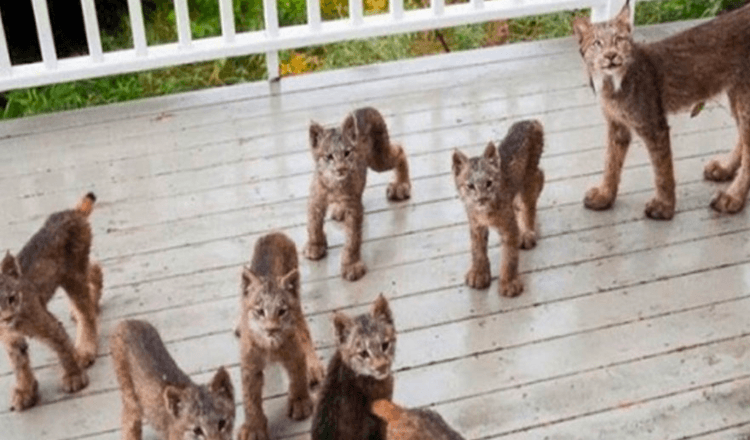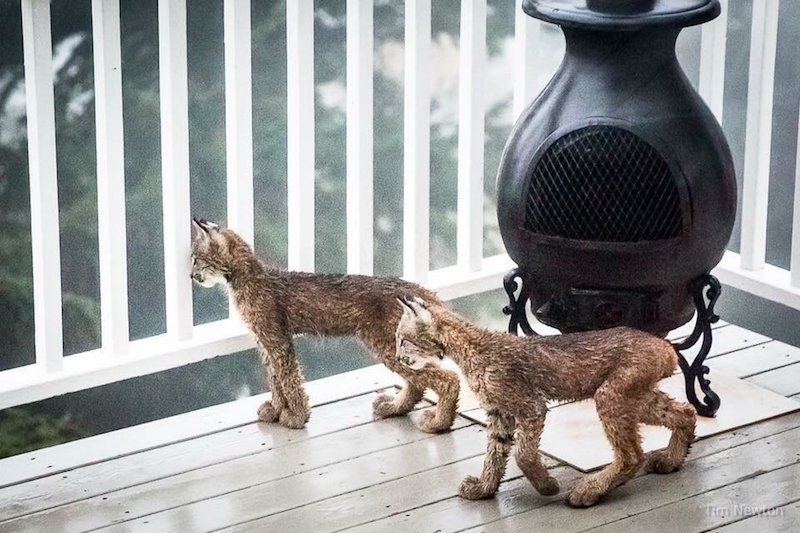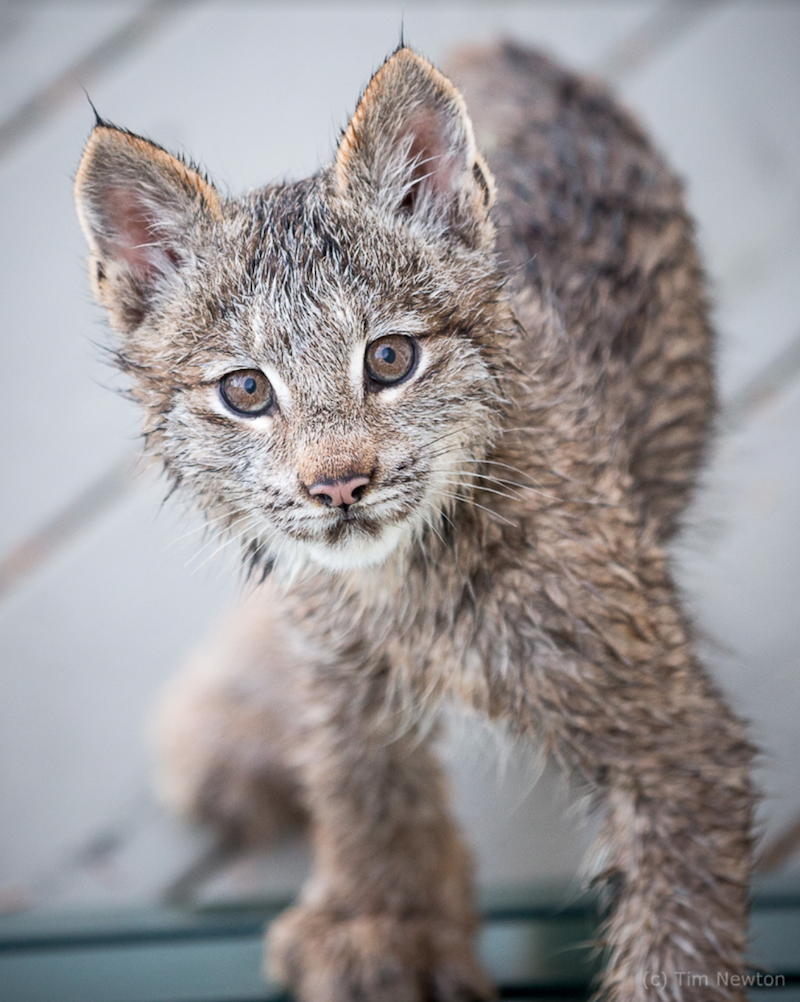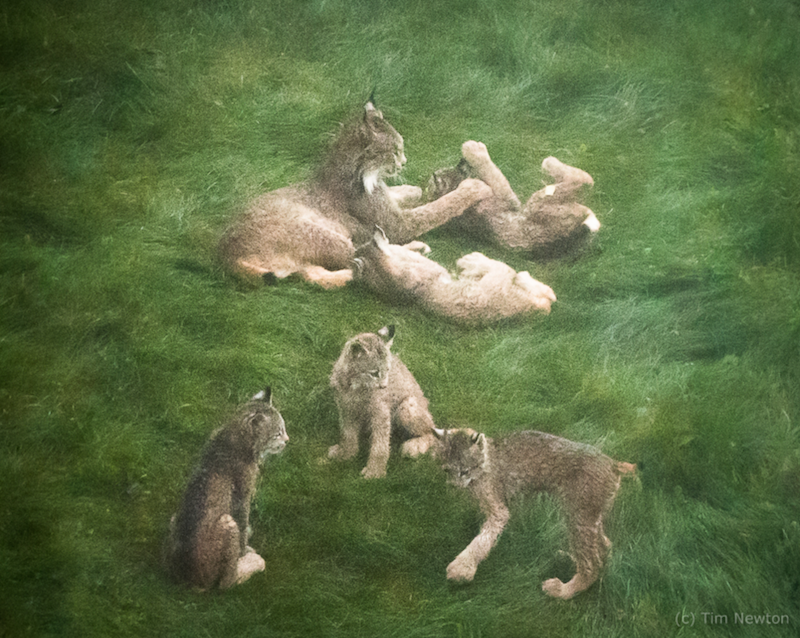Living in Alaska has its benefits, like seeing some incredible wildlife. Yet even Anchorage, Alaska resident Tim Newton was surprised when he woke up to find a lynx family playing on his porch.
At first, he just heard what sounded like someone scrambling around in his yard around dawn. His first thought was a break in and so he went to investigate the situation.

He put on his robe and crept towards the door, peeking out from behind the curtain. Thankfully, he found something beautiful instead of terrifying.
Before his very eyes he saw the cutest little family of lynx, a mother and her kittens, enjoying some good old fashion fun in his yard.
The tiny lynx kittens running around with their siblings were nearly close enough to touch.

Newton watched in awe as 6 or so more kittens joined their siblings on the deck to play. They couldn’t have picked a better yard to play in. After all, Newton is an animal lover and avid photographer.
He wasted no time at all rushing to grab his camera. He returned to find them still actively playing. That’s when he began taking as many photos as he could.
He said that the little lynx family hung around for about forty minutes. During which time they were wrestling, running, and rolling around.

When play time came to an end, mama lynx led her babies back toward the forest where they’d come from.
Newton was sad to see them go but he couldn’t contain his excitement over seeing them in the first place.
Plus, he’d captured so many incredible photos of the family at play. He shared them online, and the photos have since gone viral, to no one’s surprise.

“It was right near dawn. I heard some noises; it was like something scrambling on the deck,” Newton shared in an interview with The Dodo. “Coming out of my slumber, I thought, ‘What the heck is that?’”
“So I put on my bathrobe and slowly eased back the curtain. And right there, 2 feet away, was a lynx kitten. He was sitting there watching his siblings race by.”
“They were running back and forth, pouncing on each other. I started snapping away. I thought, ‘Wow! What incredible luck. This just beats all. This is just wonderful!’”
As the rest of us are surely thinking right about now, “They were so cute. It was cute-tastic,” Newton said.

“They were running back and forth, pouncing on each other. I started snapping away. I thought, ‘Wow! What incredible luck. This just beats all. This is just wonderful!’”
As the rest of us are surely thinking right about now, “They were so cute. It was cute-tastic,” Newton said.
Newton is forever “thankful to have seen these lynx up close.” Even living in Alaska, this kind of close doesn’t happen every day.
There is a decent number of lynx living in Alaska, especially in areas that offer a lot of food. Still, like most cats, lynx like to stay under the radar and are not often spotted by humans.

It surprises most to find out that the first documented lynx den didn’t come about until 2015. Around this time, the US Fish and Wildlife Service started collaring lynx in the Tetlin National Wildlife Refuge in order to learn more about the species.
Today, lynx live almost exclusively in Alaska (aside from the southeastern part of the state) and Canada, where there is plenty of snowshoe hare – their favorite dietary staple.
The lynx will also eat squirrel, ptarmigan, and other small rodents, but it’s a known fact that they prefer hare over any other meal.
Other types of lynx live in other parts of the world. For instance, the Iberian lynx resides in Southern Spain, although populations are on the decline and the species is expected to go extinct within fifty years.
In the past, it would have been easier to spot lynx in more parts of North America. The lynx used to live south of Canada and down into the lower 48 states.

There were more of these beautiful cats back in the day, before trapping and timber harvesting caused their numbers to take a hit.
The lynx is currently protected under the Endangered Species Act and is listed as a threatened species.
What five characteristics do all animals have in common?
What five characteristics do all animals have in common?
In the following slides, we’ll explore the basic characteristics shared by all (or at least most) animals, from snails and zebras to mongooses and sea anemones: multicellularity, eukaryotic cell structure, specialized tissues, sexual reproduction, a blastula stage of development, motility, heterotrophy and possession …
What characteristics do all animals have in common quizlet?
The six characteristics that all organisms in the animal kingdom share are: they are multicellular, almost all can move, their cells have no cell wall, they have to hunt for their own food (consumers), they are eukaryotic, reproduce sexually-when two cells join to form off spring and their cells lack chloroplasts.
What 4 characteristics do all animals share?
Most animals share these characteristics: sensory organs, movement, and internal digestion. All of them are illustrated in Figure below. Animals can detect environmental stimuli, such as light, sound, and touch. Stimuli are detected by sensory nerve cells.
What are the 7 characteristics of all animals?
- 1 Nutrition. Living things take in materials from their surroundings that they use for growth or to provide energy.
- 2 Respiration.
- 3 Movement.
- 4 Excretion.
- 5 Growth.
- 6 Reproduction.
- 7 Sensitivity.
What are the 6 characteristics common to all animals?
They are as follows:
- All animals are made up of cells that do not have cell walls.
- All animals are multicellular organisms.
- Most animals reproduce sexually.
- All animals are capable of self-propelled motion at some point in their lives.
- All animals are heterotrophic and must consume other organisms for energy.
What protein do all animals have in common?
The exctracellular protein collagen (making the most abundant extracellular protein in animals) which is required in multicellular organisms to keep the cells together, which is exclusive to animals. Most enzymes responsible for metabolic pathways.
What are the 3 characteristics of animals?
Characteristics of Animals
- Animals are multicellular organisms.
- Animals are eukaryotic.
- Animals are heterotrophic.
- Animals are generally motile.
- Animals possess specialized sensory organs such as eyes, ears, nose, skin, and tongue.
- Animals reproduce sexually.
What are the basic characteristics of all animals?
In the following slides, we’ll explore the basic characteristics shared by all (or at least most) animals, from snails and zebras to mongooses and sea anemones: multicellularity, eukaryotic cell structure, specialized tissues, sexual reproduction, a blastula stage of development, motility, heterotrophy and possession of an advanced nervous system.
What do all animals have in common with each other?
Sexual reproduction is another characteristic shared by most, but not all, animals. Regardless of species, all animals share multicellularity, which means their bodies consist of multiple cells. This sets animals apart from organisms, such as single-celled algae, fungi, bacteria and other basic life forms.
What do plants and animals have in common?
Most plants are also multicellular, so although this is a characteristic shared by all animals, it is not one unique to animals.Every animal on the planet is a eukaryote. A eukaryote is an organism that consists of cells that have membrane-bound nuclei and organelles.
What are the characteristics of the animal kingdom?
All animals are eukaryotic, multicellular organisms, and most animals have complex tissue structure with differentiated and specialized tissue. Animals are heterotrophs; they must consume living or dead organisms since they cannot synthesize their own food and can be carnivores, herbivores, omnivores, or parasites.



GIPHY App Key not set. Please check settings